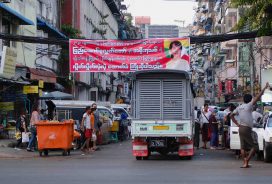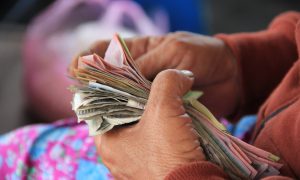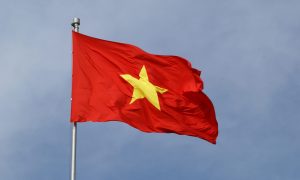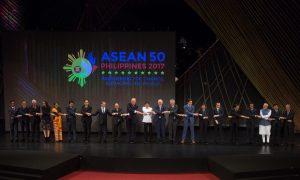A battle for international recognition between Myanmar’s junta and Aung San Suu Kyi’s deposed civilian government is underway. The opposition in the incarnation of the Committee Representing Pyidaungsu Hluttaw (CRPH) has urged the international community not to recognize the junta, while the junta has charged the CRPH as “illegal” and guilty of “high treason.”
The battle lines have been drawn with the extraordinary address to the United Nations General Assembly (UNGA) by Myanmar’s Permanent Representative U Kyaw Moe Tun. In his speech, Kyaw Moe Tun broke ranks with the junta and delivered a message from the CRPH that urged international condemnation of the coup and denial of recognition for the junta-led State Administration Council regime.
While the junta swiftly moved to sack Kyaw Moe Tun, the diplomat has staked a claim to represent the deposed civilian government at the UN. He has found support from the United States, the European Union, and a growing number of Myanmar overseas diplomats in Washington, Berlin, United Kingdom, and Tokyo. Within the region, Indonesia’s foreign minister Retno Marsudi disclosed that she had “communicated intensively” with the CRPH, signaling informal acceptance of the entity as a “stakeholder” in Myanmar’s political crisis.
In light of these developments, the United Nations Credentials Committee and the UN General Assembly are set to be the stage for a likely diplomatic contest between the CRPH provisional government and the Myanmar junta when the world body convenes for a new session in September 2021.
With this looming UN battle ahead, what role can ASEAN’s diplomats and decision-makers play? While issuing statements and convening meetings (including a potential leaders’ summit) are essential to foster collective nerve, ASEAN can be more consequential by becoming a player in struggles for diplomatic recognition between Myanmar’s two rival claimants. ASEAN—as a club of incumbents—will invariably engage with the Myanmar military at diplomatic forums, but it can deploy studied ambiguity to derogate the junta’s diplomatic standing within ASEAN and UNGA, endow limited diplomatic recognition to the CRPH, and informally create international space for Myanmar’s besieged civilian opposition.
Importantly, ASEAN has precedent and success in interceding in struggles for diplomatic recognition. This precedent—and a notorious one at that—involves ASEAN’s decade-long campaign at the United Nations during the Third Indochina War (1978-1991). During this Cold War conflict, ASEAN supported the genocidal Khmer Rouge (and its subsequent incarnations) as the legitimate representative of Cambodia at the UNGA and played a key role in the peace negotiations that brought this war to an end. If Cambodia was ASEAN’s Cold War success and infamy, Myanmar presents an opportunity for ASEAN diplomacy to write a new page in its history, even as it faces formidable internal challenges in doing so.
There are of course key differences between ASEAN’s diplomacy during the Third Indochina War and Myanmar’s current political crisis. Cold War anti-communist paranoias don’t impel decisive action; ASEAN internally is no longer a close-knit club of male diplomats and ministers managing disagreement via quiet diplomacy over golf; and there is little geopolitical convergence between the US and China (e.g. Soviet threat) that may drive a coordinated diplomatic campaign. That said, a parallel has emerged with the rise within Southeast Asia of two organized and competing claimants to state representation at the UN, and to which ASEAN is under pressure to respond.
ASEAN’s Cold War Diplomacy on Cambodia
After Vietnam invaded Cambodia in December 1978 and deposed the murderous Khmer Rouge (KR), ASEAN along with the United States and China offered a diplomatic lifeline to the KR by helping it hold on to Cambodia’s seat at the UN. The Third Indochina War was as Machiavellian as it gets and the unlikely coalition against Vietnam was a result of new, intersecting shifts in the Cold War: the Sino-Soviet Split, US-China rapprochement, the end of US-Soviet détente, and Sino-Vietnamese relations poisoned by the Cultural Revolution. This anti-Vietnam coalition was glued by anxieties over Vietnam’s supposed aspirations to regional hegemony, the spectre of Soviet influence in the region, and dangers to Thailand’s security as a “frontline” state for capitalist Southeast Asia (all members of ASEAN).
ASEAN’s foreign ministers kicked into action immediately after Vietnam’s invasion. Within a month (in January 1979), Indonesia issued a Chair’s statement, and ASEAN Foreign Ministers met in Bangkok and issued a Joint Statement condemning the invasion (compare with the two Chairman’s Statements on Myanmar). Following this initial articulation of position, ASEAN initiated a diplomatic offensive the same year at the meetings of the Non-Aligned Movement (NAM), the United Nations General Assembly (UNGA) and at the Commonwealth Heads of Government Meetings (CHOGM).
At NAM, ASEAN defended the Khmer Rouge’s Democratic Kampuchea (DK) as Cambodia’s legitimate representative at meetings held in Havana (1979) and New Delhi (1981). In the face of formidable opposition from Cuba and India, the KR lost its seat, and the Cambodia seat was left “vacant.” Despite this loss, ASEAN managed to keep the Kampuchea issue alive in NAM statements and communiques.
While results at NAM were mixed, ASEAN’s biggest success was at the UN. At the 34th United Nations General Assembly (UNGA) in 1979, ASEAN successfully lobbied for the KR to hold on to the Cambodia seat and an ASEAN sponsored resolution (calling for a ceasefire and withdrawal of Vietnamese troops) was adopted by the UNGA. Next year, at the 35th UNGA, Vietnam introduced a competing resolution co-sponsored by the Soviets. But the ASEAN sponsored resolution prevailed again, and the Khmer Rouge led DK retained its UN seat with three more votes.
ASEAN also effectively internationalised the Kampuchea issue by calling for an International Conference on Kampuchea (ICK). This was in contrast to the Vietnamese who had called for a two-phase approach with a regional conference as a first step. The ASEAN-initiated ICK was held in 1981 in New York and was attended by 79 countries.
Why and how ASEAN resolutions prevailed at the UN had to do with geopolitics (US-China support) but also skilful diplomatic lobbying by ASEAN states. Indeed, the Third Indochina War was formative for the foreign ministries and diplomats in capitalist Southeast Asia. Accounts of UNGA lobbying are lionized and often part of various foreign ministries’ “war stories.”
At first, ASEAN’s diplomatic strategy was to ensure that DK would retain the Cambodia seat at the UN and avoid two outcomes: allowing the seat to go “vacant” or slip into the control of the rival Vietnam backed People’s Republic of Kampuchea (PRK) regime in Phnom Penh (of which Hun Sen was then foreign minister).
But ASEAN’s decision makers were keenly aware of an “image” problem in backing a regime that had butchered a quarter of its country’s population. As early as 1979—when ASEAN initiated its diplomatic offensive—efforts were made to cobble together an internationally acceptable coalition government that would dilute the KR’s identity. Singapore and Thailand took lead roles in consulting, cajoling, and threatening the three factions that came to comprise this coalition: the exiled Prince Sihanouk, the ex-Prime Minister Son Sann, and leaders of the KR.
This government-in-exile, called the Coalition Government of Democratic Kampuchea (CGDK), was established in 1982, nearly three years after Vietnam’s invasion and almost entirely because of ASEAN’s diplomatic efforts. Historian Ang Cheng Guan writes “had the coalition not been formed before the approaching 37th UNGA, it was anticipated that there would have been an erosion of support for DK credentials.”
Through the 1980s, Sihanouk headed the CGDK but the Khmer Rouge were in control on the ground. UN aid was funnelled to keep the three factions alive. ASEAN sponsored resolutions continued to secure support at successive UNGAs. Only in 1990 did the Cambodia seat become vacant (not by vote, but only incidentally when Kampuchean factions failed to assemble a delegation in the lead up to the 1991 Paris meetings which ended the war).
To be sure, ASEAN diplomats often recount their abhorrence at working with KR officials (especially Ieng Sary and Ieng Thirith). They also fended off considerable pressure from China (the KR’s arch backer) as they diluted the DK into the CGDK. But ASEAN’s decision makers were ultimately architects of a diplomatic arrangement that enabled the KR to survive and allowed the Cambodian civil war to continue through the 1980s.
ASEAN’s diplomatic success in Cambodia is viewed as the pinnacle of what it achieved as a conservative and counter-revolutionary diplomatic project during the Cold War. But this association with the KR continues to bedevil ASEAN. To the wider public, this history places ASEAN on the defensive where Cold War rationales must be swiftly invoked to justify the realpolitik of the conflict. For ASEAN’s members, this history has become controversial with Cambodia’s government (which traces its lineage to the Vietnam backed PRK) dismissing ASEAN’s foundational narrative of Vietnamese “invasion” and pointing to ASEAN’s role in supporting genocide.
Can ASEAN do another Cambodia on Myanmar?
ASEAN’s Cambodia experience should remind us that we are dealing with a diplomatic project whose instincts were and remain deeply conservative. This means a diplomatic campaign in support of a deposed democratic opposition government at the UN (backed by vigorous street-level mobilization) is unlikely. It would set an unfavourable precedent for Vietnam, Thailand, Cambodia, and Laos. Democratic backsliding means that even erstwhile liberals in the ASEAN club like the Philippines show little support for working in international bodies like the UN (the Philippines has invoked Duterte-era “western hypocrisy” opprobrium towards a UN Human Rights Council statement on the coup). So far, only Indonesia and Singapore have expressly withheld diplomatic recognition from the junta, while Malaysia and Brunei have censured the coup but not commented on diplomatic recognition.
Regardless of ASEAN’s collective position, the UN diplomatic contest for recognition is likely to unfold at the UNGA. In the backdrop of growing military atrocities and an organized opposition, Myanmar’s CRPH provisional government is likely to find support. Rebecca Barber has written how the UNGA is empowered to pursue several options on Myanmar even without Security Council agreement. The UNGA can reject the credentials of the junta’s representatives with the effect of suspending the delegation without expelling the state (e.g. apartheid South Africa). It can approve the credentials of the CRPH as representatives of the deposed democratically elected government (as with Haiti 1991 and Sierra Leone 1997). Or it could use a “stalling tactic” of deferring decision on credentials such that an incumbent (but deposed) Myanmar delegation continues to represent the state (like Afghanistan 1996 and Cambodia 1997).
What can ASEAN do if and when the representation battle comes up at the UNGA? ASEAN faces two challenges.
First, and despite its conservative instincts, ASEAN will find it difficult to collectively endorse the junta in an UNGA vote, much less advocate for the junta with ASEAN sponsored resolutions à la Cambodia 1980s. Doing so would risk abdicating any regional leadership in managing the political crisis, especially from Western partners. More importantly, ASEAN will lose credibility and support from a generation of politicized civil society in Myanmar and highly connected youthful populations across the region appalled by the military’s repression. Vigorous support for the junta is also now unlikely given splits within ASEAN. While some members (Vietnam, Cambodia, Laos) may individually cast votes in favour of recognizing the junta at the UN, others like Indonesia and Singapore have sharply condemned the junta and may vote to abstain in a UN vote, if not quietly approve the CRPH’s credentials.
The second challenge ASEAN faces is that it is a club of incumbents with no political criteria for membership. This means ASEAN will grant implicit recognition to whoever makes an effective claim to represent the state and sit astride the Myanmar flag and country place card at meetings. ASEAN will also not expel nor bypass the Myanmar military (an actor with which it has much institutional memory in dealing with through the SPDC era). Despite their condemnations, the more outspoken countries in the latest political crisis, like Singapore and Indonesia, have discursively created the ground for engaging with the military as a key “stakeholder” with its supposed “special role” under Myanmar’s 2008 constitution.
These challenges mean that ASEAN will continue to interact with Myanmar’s military regime at ASEAN meetings. But it also means ASEAN will face pressure to simultaneously derogate the junta’s international diplomatic standing in the course of such engagements.
ASEAN’s diplomacy will need creativity, and here it can dip into its reserves of institutional memory from the Cold War years. During the Third Indochina War, ASEAN managed to accommodate divergent perceptions of threats (China or Vietnam) among its members by giving its blessing to outreach efforts by individual countries. Indonesia was allowed to be an “official interlocutor” with Vietnam (which it viewed as a lesser threat than China), while Thailand was allowed to take the lead in communicating with China. Indeed, Indonesia’s breakthrough in its outreach with Vietnam paved the way for the Jakarta Informal Meetings and the wider peace negotiations that culminated in the Paris Agreements of 1991.
Indonesia and Thailand could reprise these roles. Thailand’s Prime Minister and retired general Prayuth Chan-Ocha was in fact the first Southeast Asian leader that Myanmar’s Senior General Min Aung Hlaing reached out to with a letter for support. Meanwhile, Indonesia’s foreign minister and wider diplomatic establishment exude the confidence and savvy to engage with the CRPH and civil society actors who deserve space in a future political process. Both countries were active in the early weeks of this crisis, and it is no coincidence that the first interaction between the Indonesian foreign minister (doing shuttle diplomacy for ASEAN) with Myanmar’s military appointed foreign minister took place at a Bangkok airport in a “brief meeting” organized by the Thai Foreign Minister.
Southeast Asian states working individually or within ASEAN can also draw on a repertoire of face-saving diplomatic practices to politely work with the Myanmar junta even as they derogate its diplomatic standing. These may range from withholding the use of formal titles (Foreign Minister) even while using honorifics (“Excellencies”) in documents and meetings; strictly referring to the military delegate not by country name but by the regime’s name (State Administration Council); not issuing ASEAN Joint Communiques and Joint Statements but relying chiefly on “Chairman’s Statements” as well as alternative kinds of joint documents (“Summary of Discussions”); and issuing separate country statements alongside Chairman’s Statements to give individual countries space to withhold the junta’s standing more sharply than joint documents would allow.
At the bilateral level, individual states may choose not to replace their returning Ambassadors and allow their missions in Myanmar to pass under the care of a Chargé d’ Affaires (as Singapore did after Lon Nol’s coup in 1970). Junta appointed Ambassadors bound for Southeast Asian capitals could also be subjected to delays in being received and credentialed.
Diplomatic strategies centred on language, text, and protocol may not bring immediate respite to the tragic situation on the ground but it can have long-term consequences. During the Third Indochina War, ASEAN’s diplomatic campaign to isolate the PRK regime in Phnom Penh resulted in the denial of millions of dollars of development assistance and UN aid. In the Myanmar case, ASEAN’s diplomacy of studied ambiguity can be helpful for the democratic opposition by denying the junta’s fait accompli and enabling individual Southeast Asian states to extend a diplomatic lifeline to the CRPH through informal platforms and mechanisms. Arguably, playing the international recognition game at ASEAN and the UN—and especially with the blessings of China—may give ASEAN some leverage over the Myanmar junta as well.
Myanmar’s 2021 coup: The latest test for ASEAN’s commitment to democratic consolidation
Soft diplomatic approaches may yet allow ASEAN to act not as democratic enforcers but as democratic promoters.
ASEAN has precedent in successfully waging a battle for diplomatic recognition. The question, as ever, is whether it has the political will to reprise this role. The onus will fall on individual Southeast Asian states active on the Myanmar crisis, namely, Indonesia, Singapore, and—much more cautiously—Thailand. While Thailand will support Myanmar’s junta, it has nonetheless issued an official statement of concern (unlike other states) and is an experienced player in ASEAN formulas for quiet and informal diplomacy. The challenge for these active states involves applying peer pressure on ASEAN cohorts who neither have the stomach for supporting a democratic opposition nor the strategic view on what inaction may entail for ASEAN’s relevance to the Great Powers and its own societies.
Perhaps these more ‘active’ diplomats and decision makers could persuade their ASEAN counterparts by highlighting that there is nothing radical in supporting the CRPH. After all, a return to a constitutional government under a pro-capital illiberal democracy (with Aung San Suu Kyi style autocratic tendencies to boot) is only in line with ASEAN’s political complexion.
But more importantly, they may wish to underscore what is unprecedented about Myanmar’s latest political crisis. While youthfulness has been a historical constant in Myanmar’s democratic opposition, what is new is the salience of cross-ethnic and cross-regional solidarity alongside defections and civil disobedience by state functionaries ranging from police officers and teachers to nurses and diplomats. The nationwide anti-junta protests indicate a geographic breadth and social depth which makes this a force that ASEAN will have to reckon with now or later in some political form. Acquiescing to the junta’s armed assault will only leave ASEAN with a new generation (like Hun Sen’s rank and file) who carry grievances and long memories of ASEAN’s role in standing with the bad guys in the fight.
 Facebook
Facebook  Twitter
Twitter  Soundcloud
Soundcloud  Youtube
Youtube  Rss
Rss 



